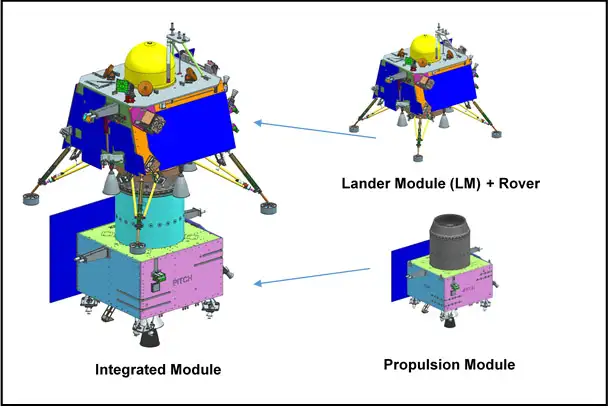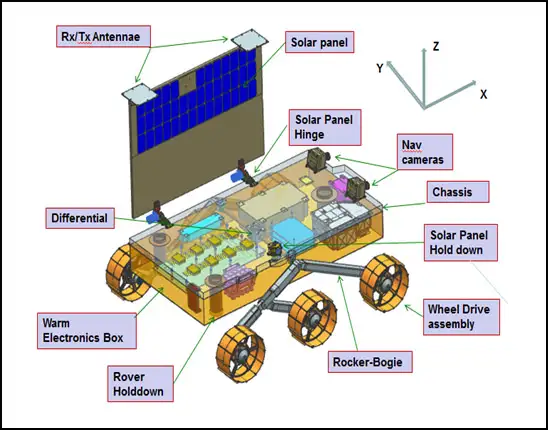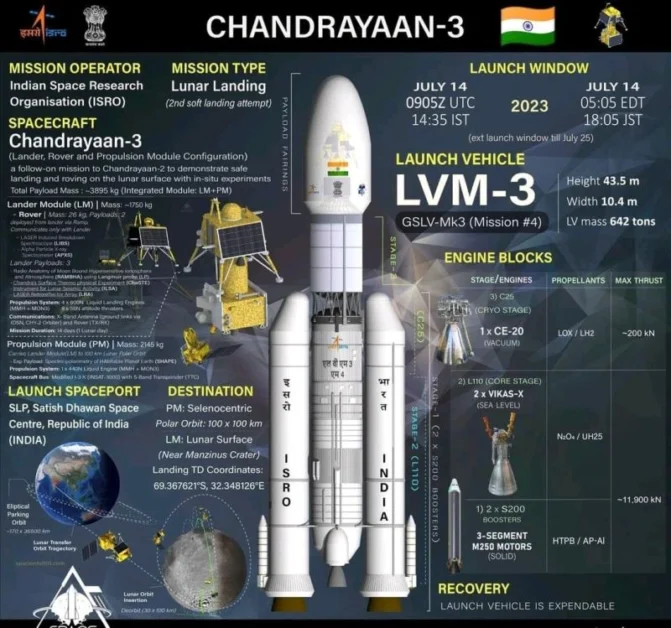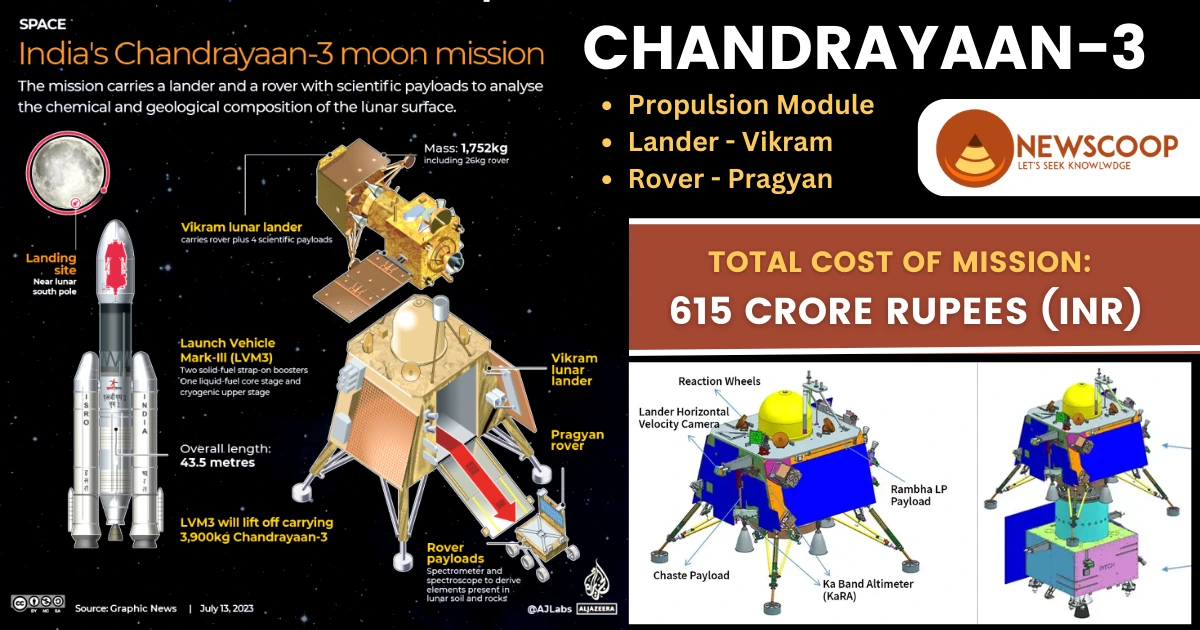Chandrayaan-3 Mission: Lander & Rover
India has been making significant strides in space exploration, and its Chandrayaan missions have been at the forefront of these endeavors. Chandrayaan-1, launched in 2008, made a groundbreaking discovery of water molecules on the Moon. Chandrayaan-2, launched in 2019, although facing some setbacks, was a significant step forward in exploring the Moon’s south polar region.
As India looks to the future of lunar exploration, it has successfully launched Chandrayaan-3. This mission represents the next chapter in India’s lunar exploration journey and showcases the nation’s unwavering commitment to unraveling the mysteries of the Moon.
| Mission | Chandrayaan-3 |
| Landed on | August 24, 2023 |
| Launch Vehicle | Launch Vehicle Mark 3 (LVM 3) or GSLV Mk III |
| Destination | Lunar South Pole |
| Mission Duration | Operates for one lunar day, approximately 14 Earth days |
| Trajectory | Follows a similar path as Chandrayaan-2 |
| Objective | To land on the Moon’s South Pole, continuing India’s lunar exploration journey |
| Cost | 615 Crore Rupees (INR) |
| Space Agency | Indian Space Research Organisation (ISRO) |
India’s Chandrayaan-3: Historic Lunar Soft Landing
India has made history with its successful soft landing on the lunar south pole, becoming only the fourth country to achieve a soft landing on the Moon, following the US, the former Soviet Union, and China.
In addition, India’s Chandrayaan-3 mission has accomplished a historic feat, becoming the first country to land on the lunar south pole.
The remarkable achievement was realized by the Vikram lander from the Chandrayaan-3 mission, which touched down as planned at 18:04 local time (12:34 GMT).
This historic mission involved two visitors from India: the Vikram lander and the Pragyan rover, both successfully reaching the southern polar region of the Moon on August 23, 2023.
Chandrayaan-3, launched in July, took a slower and more fuel-conscious route to reach the Moon. It outlasted its Russian counterpart, Luna-25, which had launched just 13 days prior but tragically crashed on August 19, 2023, due to an engine malfunction.

NASA’s Support: The Deep Space Network
To facilitate communication during the mission, India’s space agency, ISRO, has enlisted the assistance of NASA’s Deep Space Network, a network of large dish antennas. Currently, the network is actively engaged in sending and receiving signals from Chandrayaan-3.
Why August 23rd for Chandrayaan-3’s lunar landing?
August 23rd was chosen for Chandrayaan-3’s lunar landing due to its alignment with the lunar sunrise at the chosen site on the south pole. This timing ensures optimal lighting and manageable thermal conditions, critical for safe landing and scientific operations.
The decision reflects meticulous mission planning, emphasizing operational success and enabling the fulfillment of scientific objectives. This strategic date contributes to Chandrayaan-3’s milestone as the first mission to successfully land in this challenging lunar region.
Objectives of Chandrayaan Mission
The objectives of the Chandrayaan-3 mission are as follows:
- Achieve a safe soft landing on the lunar surface, particularly in the south polar region.
- Study lunar surface temperature and subterranean characteristics to enhance our understanding of lunar geology.
- Collect data on Earth’s light emission and reflection using the SHAPE instrument, potentially contributing to Earth’s atmospheric and climate studies.
- Explore the lunar surface through the rover ‘Pragyan,’ conducting chemical tests to analyze the Moon’s composition and geology.
- Investigate the presence and distribution of water ice in the lunar south pole region.
- Conduct experiments to understand the Moon’s geophysical properties, including seismic activity.
- Demonstrate advanced landing and mobility technologies for future lunar missions.
First to land on Moon’s South Pole
Chandrayaan-3 is set to make history as the first mission to land on the Moon’s South Pole, a region unexplored by previous human missions, including those from the United States. This achievement demonstrates India’s technical prowess and bold space exploration ambitions.
The South Pole’s appeal lies in its perpetually shadowed areas, which may contain Moon ice, and the potential to reveal insights into the early Solar System’s composition.
This mission’s groundbreaking tests and findings are generating global interest and collaboration in the exploration of this unique lunar terrain.
Mission Specifications for Chandrayaan-3
- Total Mass: Chandrayaan-3 has a total mass of 3900 kg, distributed between the Propulsion Module (2148 kg) and the Lander Module (1752 kg).
- Power Generation: The mission utilizes a range of power generation capacities, from 50W for the Rover to 758W for the Propulsion Module, catering to various energy needs across its components.
- Communication: Communication is facilitated via IDSN (Indian Deep Space Network) links for both the Propulsion Module and Lander. Additionally, a contingency communication link is established with the Chandrayaan-2 Orbiter, ensuring mission resilience and reliable data transmission.
Total Cost of Chandrayaan
- Chandrayaan-1 (2008): The Chandrayaan-1 mission had an actual cost of approximately 386 Crore Rupees (INR).
- Chandrayaan-2 (2019): The Chandrayaan-2 mission, which included an orbiter, lander (Vikram), and rover (Pragyan), had a total cost of about 960 Crore Rupees (INR).
- Chandrayaan-3 (2023): The Chandrayaan-3 mission, which aims to land on the lunar South Pole, has a confirmed cost of 615 Crore Rupees (INR).
Components of Chandrayaan-3
Chandrayaan-3, the lunar mission, comprises three primary components:
- Propulsion Module
- Lander
- Rover
1. Propulsion Module

- Carries lander and rover to lunar orbit.
- Equipped with a large solar panel and mounting structure for the lander.
Propulsion Module Payload:
- Spectro-polarimetry of Habitable Planet Earth (SHAPE): Conducts spectral and polarimetric measurements of Earth from lunar orbit in the near-infrared wavelength range, offering valuable data for Earth studies.
2. Lander (Vikram)

- Responsible for soft landing on the Moon’s surface.
- Features four landing legs and four landing thrusters.
- Improved attitude control and thrust capabilities.
- Stronger impact legs, and enhanced redundancy in instrumentation.
- Targeting a precise 4 km by 4 km landing region.
Lander Payloads:
- Chandra’s Surface Thermophysical Experiment (ChaSTE): Measures lunar surface thermal conductivity and temperature.
- Instrument for Lunar Seismic Activity (ILSA): Records seismic activity around the landing site.
- Langmuir Probe (LP): Estimates near-surface plasma density changes over time.
3. Rover (Pragyan)

- A six-wheeled vehicle weighing 26 kilograms.
- Designed for various lunar surface measurements.
- Aims to analyze lunar composition, detect water ice, study lunar impact history, and explore the Moon’s atmosphere evolution.
Rover Payloads:
- Alpha Particle X-Ray Spectrometer (APXS): Analyzes the chemical composition and infers the mineralogical composition of lunar surface materials.
- Laser-Induced Breakdown Spectroscope (LIBS): Determines the elemental composition of lunar soil and rocks, focusing on elements like magnesium, aluminum, silicon, potassium, calcium, titanium, and iron.
Mission Life Durations
- Propulsion Module: Operational for up to six months during the journey to the lunar orbit.
- Lander Module: Active for one lunar daylight period, equivalent to about 14 Earth days.
- Rover Module: Functional for one lunar daylight period, also lasting about 14 Earth days.
These mission durations are optimized for specific phases of the Chandrayaan-3 mission.
LVM-3: India’s ‘Bahubali’ Rocket (GSLV Mk III)

The LVM-3 is India’s heavyweight launch vehicle, earning it the nickname ‘Bahubali’ (meaning ‘strong man’). It’s the most potent rocket developed by ISRO and stands unmatched in its class. Here’s how it works and some key details:
Structure and Power:
- LVM-3 is a three-stage rocket with two solid-fuel boosters and a liquid-fuel core stage.
- The solid-fuel boosters provide initial thrust, while the liquid-fuel core stage ensures sustained thrust to carry the rocket into orbit.
- It’s powered by two solid strap-on motors (S200), one liquid core stage (L110), and a high-thrust cryogenic upper stage (C25) with 28 tons of propellant.
Capacity:
- LVM-3 has a lift-off mass of 640 tonnes, making it exceptionally powerful.
- It can carry payloads of up to 4,000 kilograms into geosynchronous transfer orbit (GTO).
Notable Missions:
- LVM-3 has successfully launched various satellites, including the GSAT-19 communication satellite, Astrosat astronomy satellite, and the Chandrayaan-2 lunar mission.
- It’s also scheduled to launch the Gaganyaan crewed mission, India’s first human spaceflight.
Operation:
- The rocket operates using a staged combustion cycle with liquid-fueled engines for its core and strap-on boosters.
- The core stage features two Vikas engines with 720 kN thrust each.
- Solid propellant boosters provide extra thrust initially.
- The upper stage uses the indigenously developed cryogenic CE-20 engine.
Achievements:
- Formerly known as GSLV Mk III, it’s now rebranded as LVM-3 and has completed three successful missions.
- Chandrayaan-3 will be its fourth mission, extending its impressive track record in launching payloads beyond Earth’s orbit.
The LVM-3, India’s ‘Bahubali’ rocket, has significantly enhanced India’s capabilities in launching heavier payloads, particularly communication satellites, into space.
Why Explore the Moon?
- Time Capsule of Earth’s History: The Moon, formed from Earth, preserves records of our planet’s early history, safeguarding information erased by Earth’s geological processes.
- Understanding Earth’s Origins: Studying the Moon provides invaluable insights into the origins of Earth, shedding light on the conditions and events that shaped our planet.
- Earth-Moon System Dynamics: The Moon’s existence is intimately linked to Earth’s. Exploring the Moon helps us understand the formation and evolution of the Earth-Moon system, unveiling celestial forces at play.
- Insights into Cosmic Impact: Lunar craters are a testament to a history of asteroid impacts, offering insights not only into lunar history but also into the impact risks Earth faces.
- A Cosmic Time Capsule: The Moon is more than a celestial neighbor; it’s a cosmic time capsule, a portal to Earth’s infancy, and a key to our place in the universe.
Impact of Chandrayaan’s Success on India
The success of Chandrayaan has had profound and far-reaching effects on India, spanning multiple dimensions:
- Technological Advancement: Chandrayaan’s success showcases India’s technological prowess on a global stage. It bolsters the nation’s confidence in its capabilities and inspires future innovations in space technology and related fields.
- Scientific Achievement: Successful missions like Chandrayaan expand India’s scientific knowledge base. The data and findings from lunar exploration contribute to scientific research, enabling breakthroughs in planetary science, geology, and astrophysics.
- Global Recognition: India’s achievements in space exploration enhance its global standing. Chandrayaan reinforces India’s position as a key player in the international space community, leading to collaborations and partnerships with other spacefaring nations.
- Economic Opportunities: Success in space missions opens up economic opportunities. It stimulates the domestic space industry, fostering innovation, job creation, and revenue generation through satellite technology and space applications.
- Inspiration for Future Generations: Chandrayaan’s success inspires young minds in India to pursue careers in science and technology. It serves as a beacon of hope, encouraging students to dream big and aim for excellence in space-related fields.
- Strategic Advantage: India’s space capabilities offer strategic advantages, including enhanced communication, navigation, and remote sensing capabilities. These assets have implications for national security, disaster management, and resource utilization.
- International Cooperation: Successful missions foster international cooperation. India’s space agency, ISRO, collaborates with space agencies worldwide, leading to knowledge exchange, joint missions, and a stronger global presence.
- Space Diplomacy: India’s space achievements facilitate space diplomacy. It promotes diplomatic relations and goodwill with other nations, serving as a tool for positive engagement on the international stage.
- National Pride: Chandrayaan’s success fosters a sense of national pride and unity. It serves as a symbol of India’s determination and potential to achieve greatness in scientific and technological endeavors.
Conclusion
Chandrayaan-3 marks India’s audacious mission to the Moon’s South Pole. This triumph underscores India’s technological prowess and global prominence in space exploration.
This mission promises to uncover lunar mysteries, inspire generations, and boost international cooperation. It epitomizes India’s space journey, bringing pride and limitless potential to the nation.
Chandrayaan-3’s message is clear: In the quest for knowledge and discovery, the sky is just the beginning.
Thank You!

